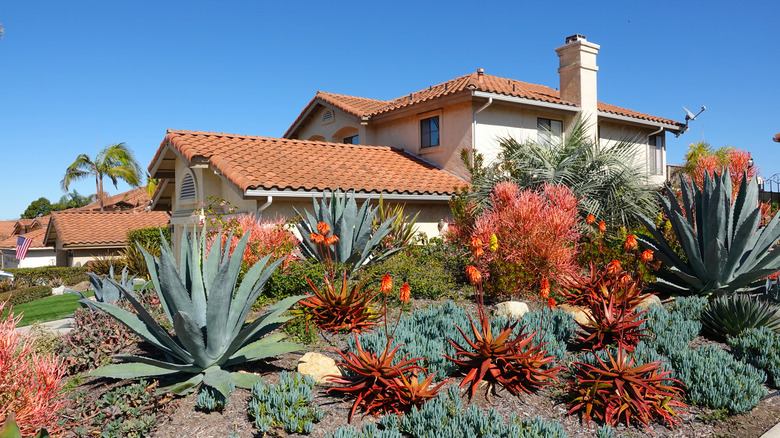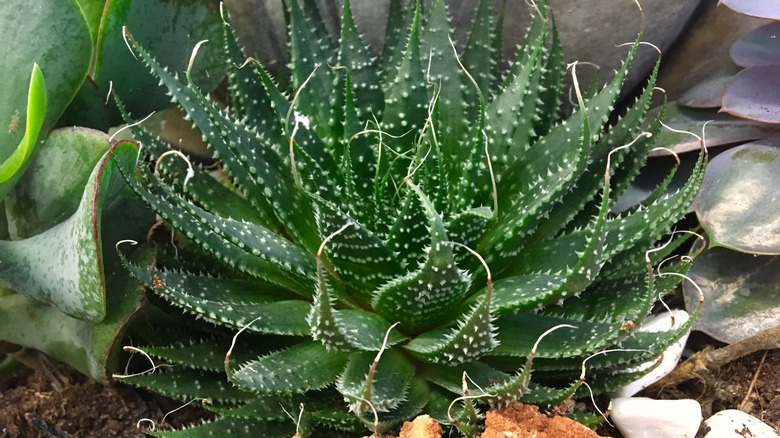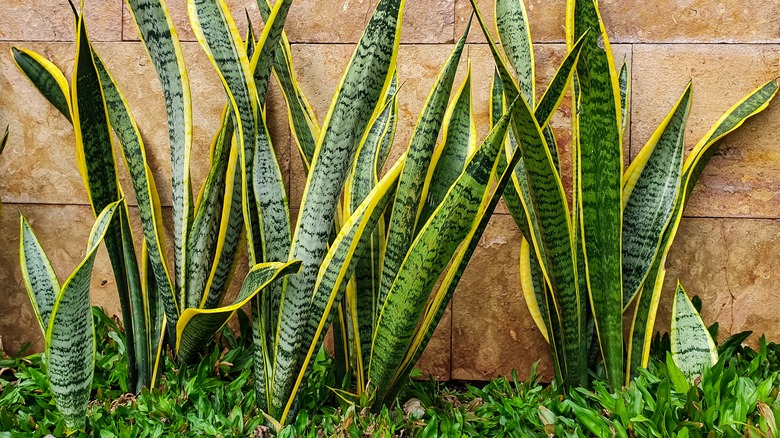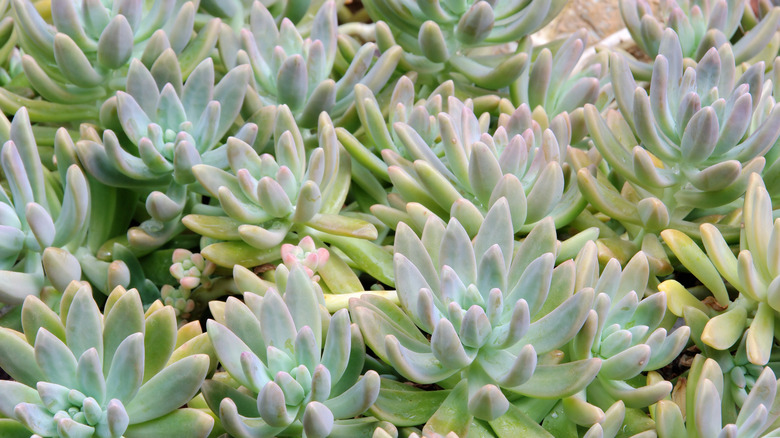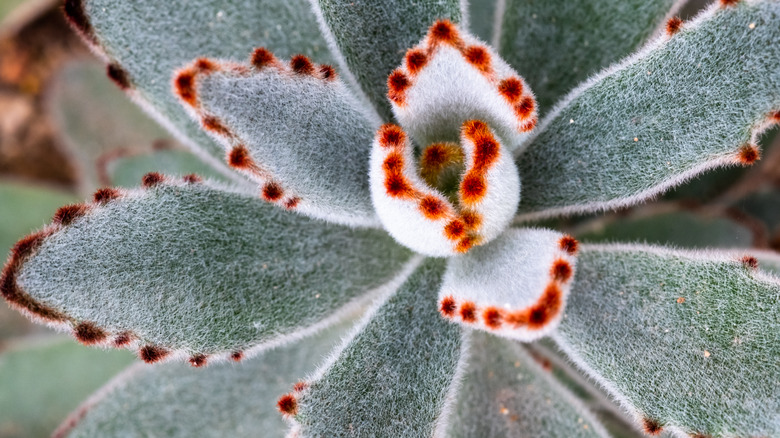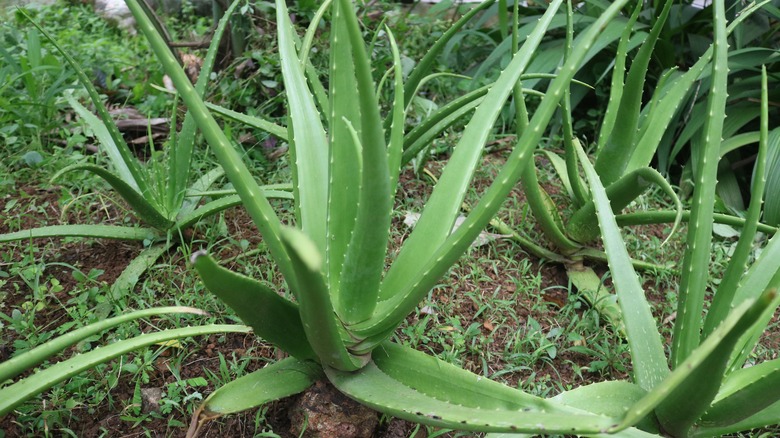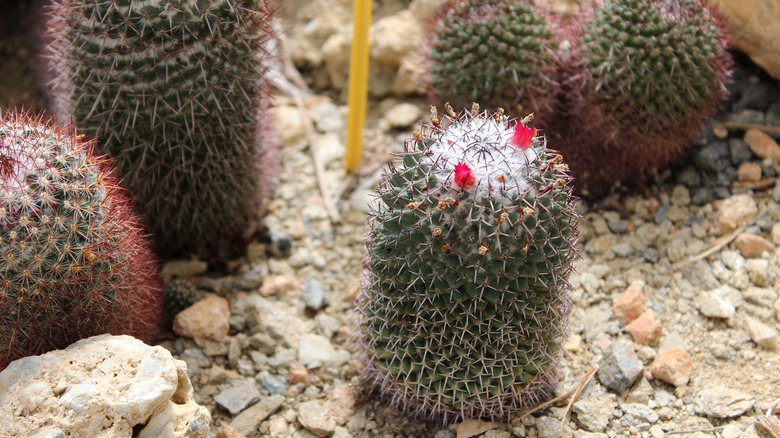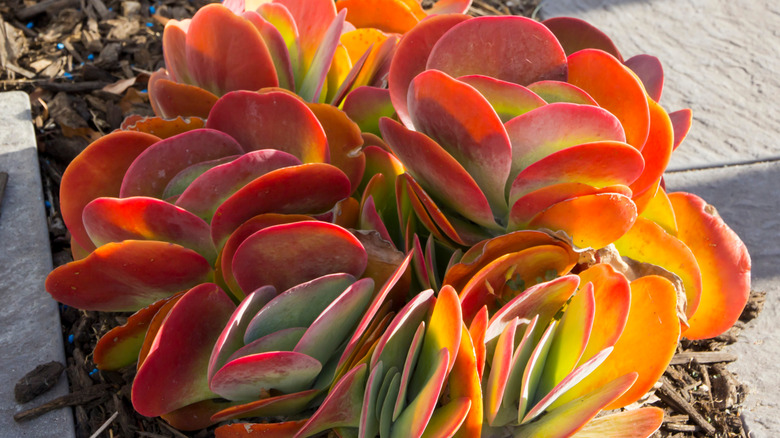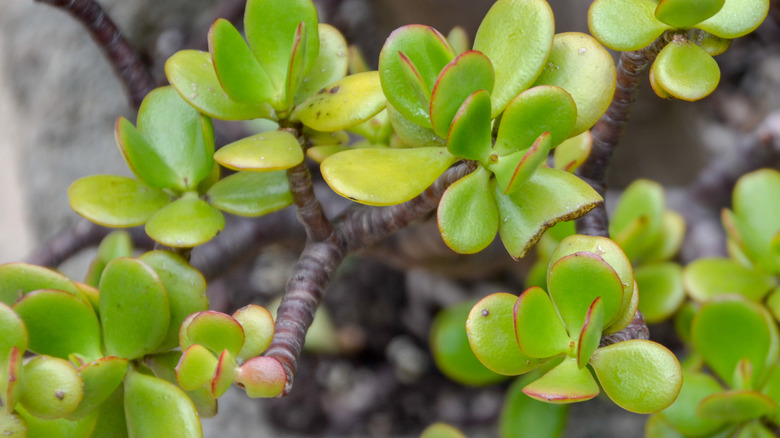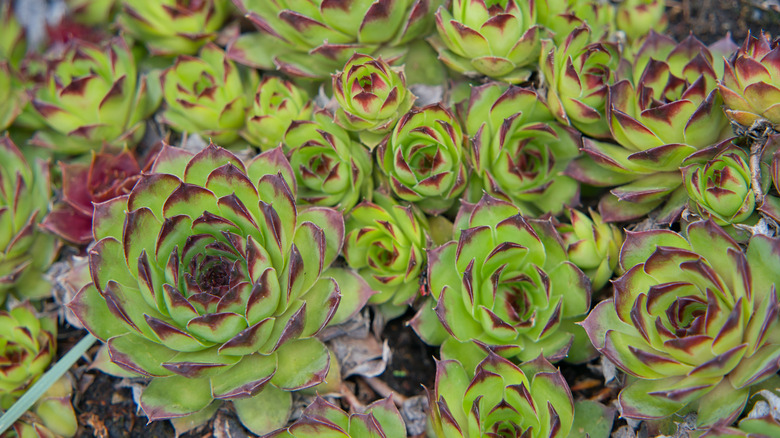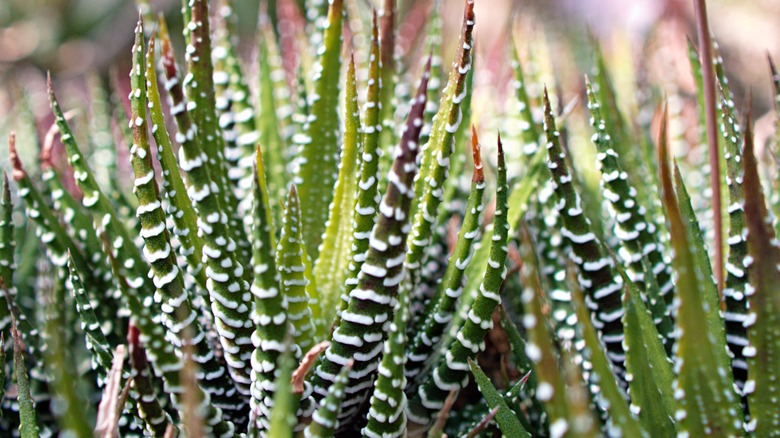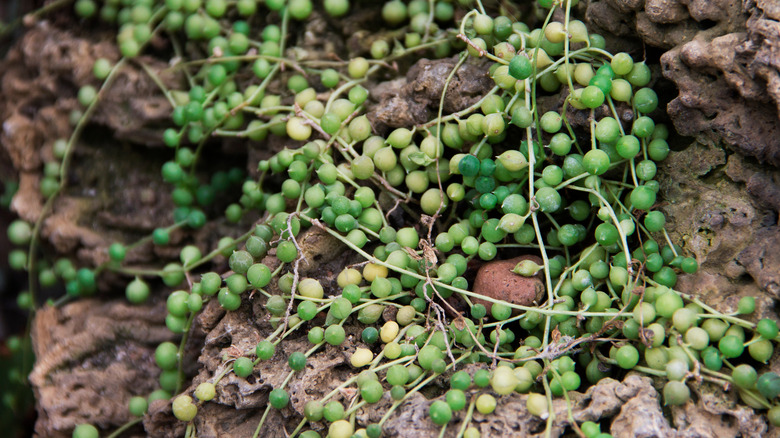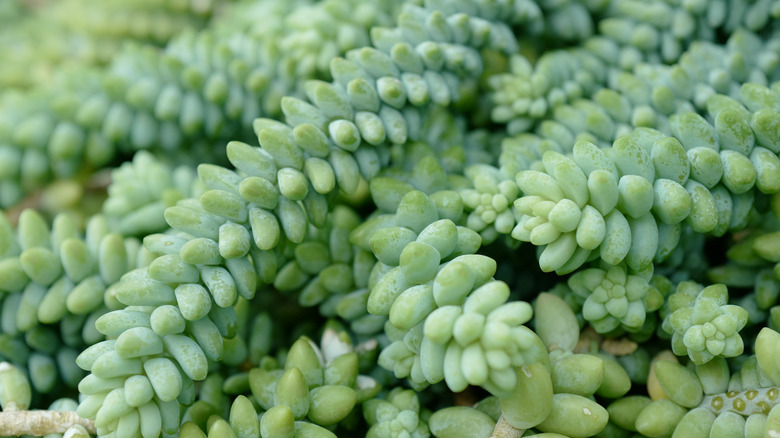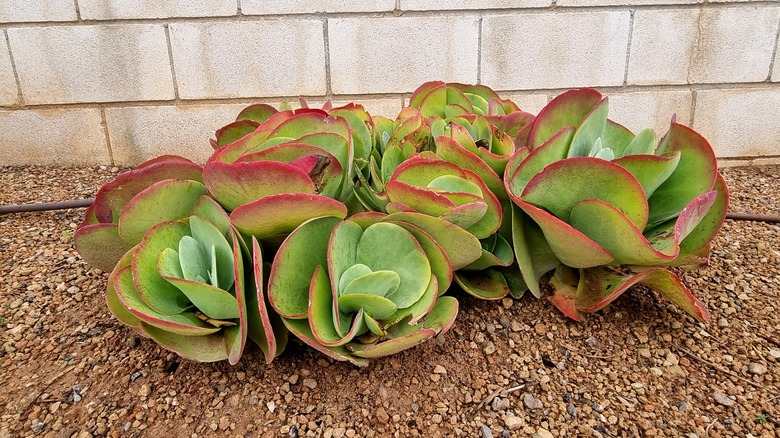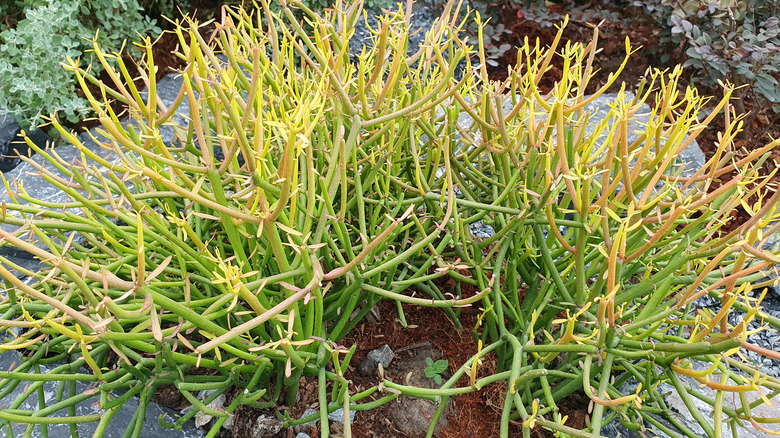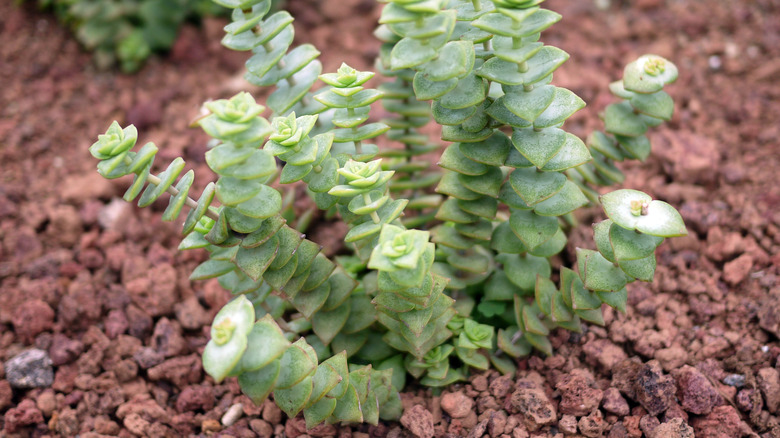15 Succulents To Enhance Your Drought-Friendly Lawn
When you live in an area that doesn't receive much rainfall, growing beautiful plants that enhance your lawn is a challenge. Drought-friendly lawns can be composed of native plants, drought-resistant grasses, living ground cover plants, and more, as suggested by The Washington Post. These lawn alternatives are great on their own, but they can be made even more visually interesting by adding some of these succulents.
Most succulents have very similar care needs. They enjoy direct sunlight, warm weather, and well-draining soil, though some outliers don't fit that criterion. For example, jade plants can grow in full shade. One thing that you'll find is true with all 15 of these succulents, and many more, is that they require very infrequent watering. They are built for drought conditions, which makes them perfect additions to any drought-friendly lawn. Just take a look at our list of plants that can survive a wicked dry spell, and you'll be well on your way to turning your yard into a unique, nearly waterless garden.
1. Lace Aloe
Lace aloe (Aristaloe aristata) is a frost-hardy aloe that does well as a garden plant or a houseplant. According to Monrovia, this succulent produces pink flowers in the summertime that will attract pollinators like hummingbirds and butterflies. It also only needs occasional waterings once it is established on your lawn.
Bloom Season: Summer
USDA Growing Zone: 7 to 10
Growing Conditions: Full sun to partial shade
Soil Type: Well-drained
Size: 6 to 8 inches tall
2. Snake Plant
Snake plants (Sansevieria trifasciata) are low-maintenance succulents that grow best in the shadier parts of your garden. As told by Penn State Extension, your snake plant is unlikely to be bothered by pests, but it will quickly die if you overwater it. Be sure to check out the many varieties of snake plants before you bring one home.
Bloom Season: Spring
USDA Growing Zone: 9 to 11
Growing Conditions: Partial shade
Soil Type: Well-drained
Size: 6 inches to 3 feet tall depending on the variety
3. Red Echeveria
Red Echeveria (Echeveria harmsii) is also referred to as the plush plant. It can be identified by its dark green velvety leaves and its red-orange flowers that bloom in the spring. This cactus is great for planting in rock gardens or landscapes with dry soil, as explained by Gardenia.
Bloom Season: Spring
USDA Growing Zone: 9 to 12
Growing Conditions: Full sun or partial shade
Soil Type: Well-drained loam or sand
Size: 6 inches to 1 foot tall
4. Panda Plant
Panda plants (Kalanchoe tomentosa) are known for their fuzzy, upright leaves and their red flowers, which bloom in the spring, as per Mountain Crest Gardens. Also called 'Donkey Ears,' you can easily identify this plant by the brown spots on the edges of its leaves. The panda plant does well in succulent gardens that receive little water and lots of sunlight.
Bloom Season: Spring
USDA Growing Zone: 10 to 11
Growing Conditions: Full sun
Soil Type: Well-drained
Size: 1 foot tall
5. Aloe Vera
Aloe vera (Aloe barbadensis) is a large succulent that is planted in drought-tolerant gardens all the time. It thrives in poor soil and dry conditions, as stated by the University of Florida. With little maintenance, aloe plants consistently grow and even produce red flowers when planted outdoors.
Bloom Season: Late winter to spring
USDA Growing Zone: 8 to 11
Growing Conditions: Full sun to partial shade
Soil Type: Well-draining potting media
Size: Up to 2 feet tall
6. Pincushion Cactus
Pincushion cacti (Mammillaria spp.) are popular houseplants in colder regions, however, they can be grown just as successfully outdoors in states with the right conditions. According to North Carolina State Extension, there are more than 200 species of pincushion cacti and even more cultivars. Each of them shares similar characteristics such as their rounded shape, a halo of flowers, and drought tolerance.
Bloom Season: Summer and fall
USDA Growing Zone: 10 to 11
Growing Conditions: Full sun or partial shade
Soil Type: Well drained loam or sand
Size: 1 inch tall to 1 foot tall, varies by species
7. Flapjacks
Flapjacks (Kalanchoe spp.) are unique succulents that feature green wide and flat leaves that are often tipped with red. The common name 'flapjacks' refers to two different Kalanchoe species: K. thyrsiflora and K. luciae, via the University of Wisconsin-Madison. Both species have the same care requirements, which advise gardeners to keep them in a sunny location with little water. They look great in succulent gardens, hanging baskets, mixed containers, and rock gardens.
Bloom Season: Late winter and early spring
USDA Growing Zone: 9 to 10
Growing Conditions: Full sun
Soil Type: Well-drained
Size: 12 to 18 inches tall
8. Jade Plant
Jade (Crassula argentea) is a plant that can survive just about any condition. The succulent is known for being drought-tolerant and shade-tolerant. It can grow in poor or dry soil, as mentioned by the University of Florida. It can be identified by its thick, obovate leaves and round growth habit. Consider planting jade as a border or accent plant.
Bloom Season: Spring
USDA Growing Zone: 10 to 11
Growing Conditions: Full sun, partial or full shade
Soil Type: Well-draining, sandy, loamy, or acidic
Size: 2 to 4 feet tall and 1 to 3 feet wide
9. Common Houseleek
The common houseleek (Sempervivum tectorum) is a great option for those who regularly neglect their garden. This mat-forming succulent needs almost no water and full sun conditions, as described by Gardenia. Common houseleek succulents should be planted in an area with well-draining soil. This soil can be poor and dry. It should also be sandy or gravelly. Try using this plant in a Mediterranean garden or succulent garden.
Bloom Season: Summer
USDA Growing Zone: 3 to 8
Growing Conditions: Full sun
Soil Type: Well-drained loam or sand
Size: 6 inches to 1 foot tall
10. Zebra Plant
Zebra plants (Haworthiopsis attenuata) are typically grown as houseplants due to their love for shady environments, but they will make a stunning addition to the shadiest part of your drought-friendly lawn. This succulent is extremely easy to care for and its thick, pointed leaves with white speckles make it a unique specimen, as per Mountain Crest Gardens.
Bloom Season: Summer
USDA Growing Zone: 10 to 11
Growing Conditions: Partial shade
Soil Type: Well-drained
Size: 3 to 5 inches tall
11. String of Pearls
The string of pearls (Senecio rowleyanus) is an odd plant that features spherical leaves that resemble green pearls. This trailing succulent is native to eastern South Africa where it thrives in dry and warm conditions. Though the plants look great in hanging baskets, they can also be used as accent plants as they creep across the ground and around rocks to form dense mats, says the University of Wisconsin-Madison.
Bloom Season: Summer
USDA Growing Zone: 9 to 11
Growing Conditions: Full sun or partial shade
Soil Type: Well-draining
Size: 1 to 3 feet long
12. Sedum Burrito
Sedum burrito (Sedum morganianum) is known as a trailing soft succulent, according to Mountain Crest Gardens. This plant, which originated in Veracruz, Mexico, is very tolerant of neglect and drought. When planting sedum burrito outdoors, make sure that it will receive adequate sunlight and that you grow it in gritty soil. With good care, you may be rewarded with pink blooms in the spring.
Bloom Season: Spring
USDA Growing Zone: 10 to 11
Growing Conditions: Full sun or partial shade
Soil Type: Well-drained
Size: 3 feet long stems
13. Pig's Ear
Pig's ear (Cotyledon orbiculata) is characterized by green wide and flat leaves tipped with red, similar to the flapjack plant. This succulent is native to South Africa where it grows in the dry and warm mountainous areas, as noted by High Country Gardens. You may place the pig's ear plant in a container, or you can grow it in your yard where it won't be killed by too much water.
Bloom Season: Summer to fall
USDA Growing Zone: 6 to 10
Growing Conditions: Full sun
Soil Type: Well-drained sandy or dry
Size: 6 to 8 inches tall
14. Pencil Cactus
Pencil cacti (Euphorbia tirucalli) are tall plants that do well in poor soil and drought. They are characterized by thin, spineless branches that point every which way to create a hedge-like form. North Carolina State Extension warns that you should be careful where you plant this cactus. If you, your child, or your pets consume its sap, it may lead to vomiting, diarrhea, or nausea.
Bloom Season: Spring and summer
USDA Growing Zone: 9 to 11
Growing Conditions: Full sun and partial shade
Soil Type: Well drained clay, loam, or sand
Size: 20 to 30 feet tall
15. String of Buttons
String of buttons plants (Crassula perforata) look quite similar to sedum burrito plants, though some gardeners prefer this species of Crassula for its spiraling green and red stems. Often used in rock gardens, Mediterranean gardens, or as ground cover, this succulent is a suckering plant that will form small colonies when left alone, explains MasterClass. It requires very little care and it should not be overwatered.
Bloom Season: Spring
USDA Growing Zone: 9 to 12
Growing Conditions: Full sun to partial sun
Soil Type: Well-drained loam or sand
Size: 1 to 2 feet tall
